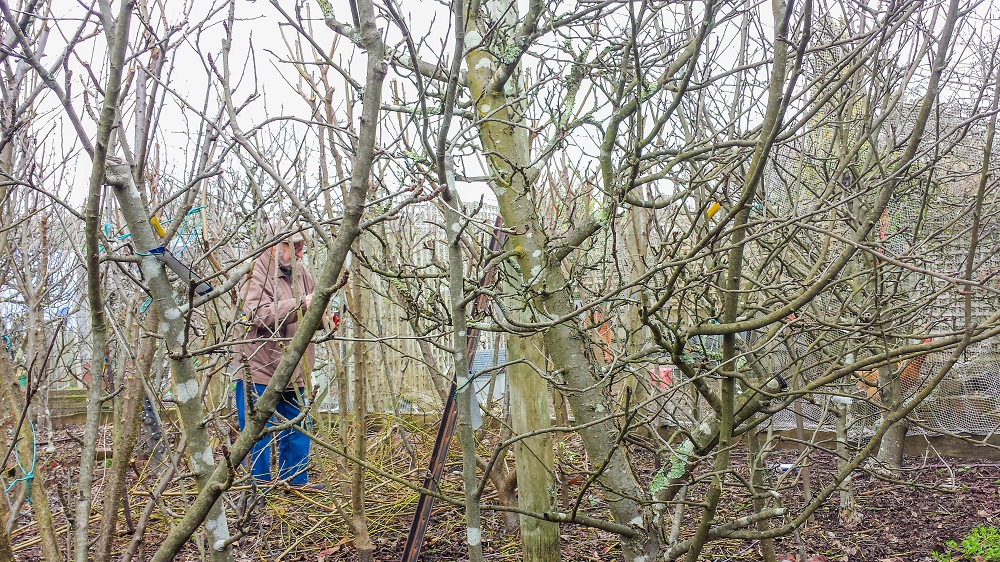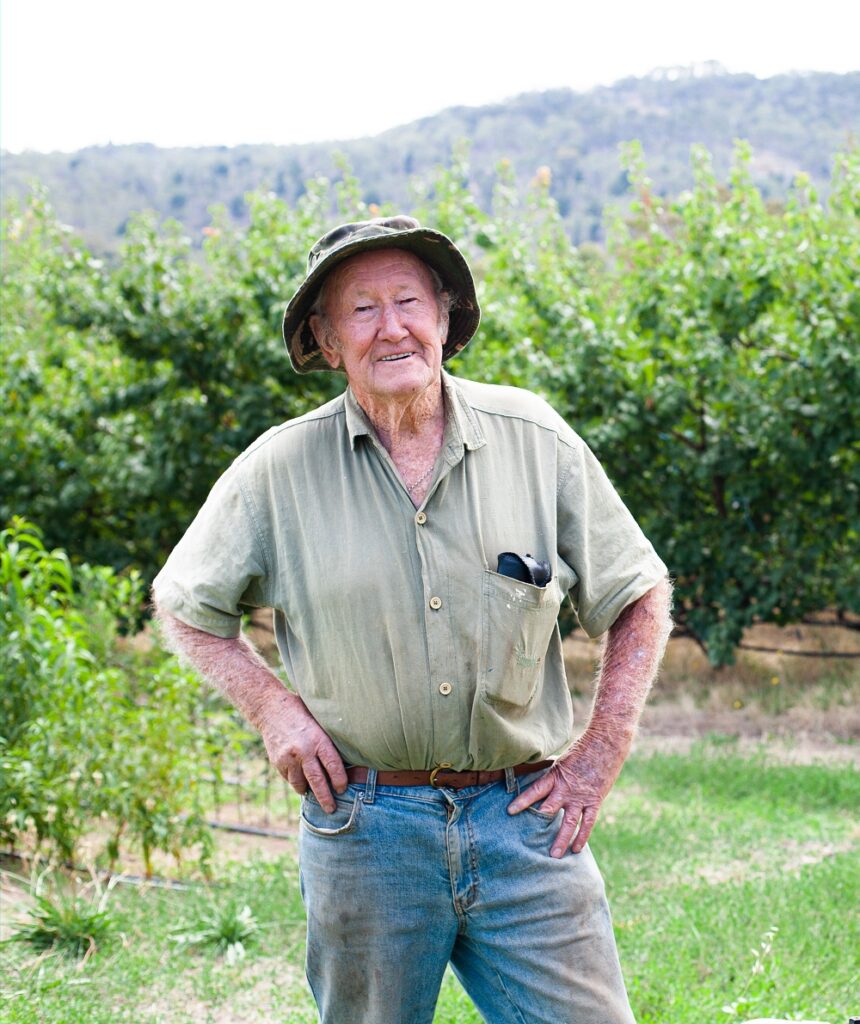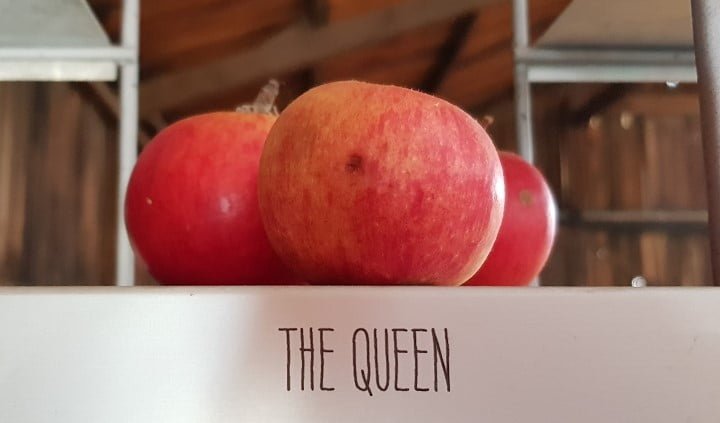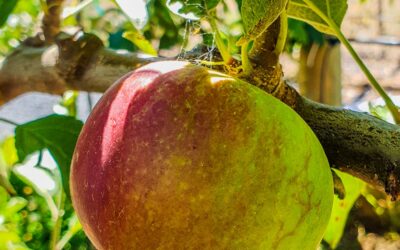Estimated reading time: 6 minutes
Here at Grow Great Fruit Central, we LOVE heritage and heirloom apples. In fact, we’ve planted a whole orchard to build a collection and preserve as many as possible.
The really exciting thing about the heritage orchard is the diversity of apples that we’ve planted.
We’re aiming for at least 100 varieties. At the moment there are about 81, with more going in each year.
So, why so many varieties? And why are we focusing on heirloom varieties that no one’s heard of, and hardly anyone grows?
7 reasons to grow heirloom varieties
Growing heritage varieties fits with our philosophy in a number of ways:
- We’re on a mission to teach as many people as possible how to grow their own organic food and become self-sufficient for food. The heritage orchard will be a great teaching resource.
- It further increases the diversity (as opposed to monoculture) on the farm, something we aim for at every level. We’ve learned the hard way that it’s our best protection against the risks of farming.
- To learn more about apple varieties, The more varieties we grow, the better the advice we can offer about early, mid-season, and late varieties.
- We’re always keen to extend the length of the growing season. The longer you can harvest fresh fruit (and vegetables, for that matter) from your garden, the less time you’re relying on supply from elsewhere.
- We love having more variety on our table and in our diets.
- It will help to preserve heritage varieties that are currently in danger of being lost completely.
- It will give us a better diversity of apples that are suited to eating, cooking, juice, and cider.
A few thank-you’s
Our farm is also a community, so we want to thank a few important people who helped us get the heritage apple venture off the ground.
A huge thank you to the lovely Smith family, who enthusiastically jumped in and helped us plant the trees. Sue Smith was a huge supporter of our farm (and got her whole family involved) before she sadly passed away. We think of her often when we’re in the heritage apple orchard.

Keith Robertson, from the Creswick Garden Club
Keith is a collector with the most amazing collection of more than 700 apple varieties in his suburban backyard in Creswick.
He was generous enough to let us follow him around for a wonderful day gathering scion wood to graft the heritage apple trees.
We only had room to take a fraction of his collection, but he thoughtfully followed our brief that we wanted varieties that (a) he knew something about (whether they’re for eating, cider, or cooking) and (b) would extend our season by being earlier or later than existing varieties that we grow.

Merv Carr (Katie’s Dad)
Despite having theoretically retired many years ago, Merv is still the driving force behind our on-farm Carr’s Organic Fruit Tree Nursery (which is named in his honour).
The nursery grows hundreds of trees each year which are sold to the public in winter. We treasure Merv’s involvement and the chance to learn his fabulous skills.

What’s a “heritage” apple anyway?
The word “heritage” is sometimes interchanged with “heirloom” (and occasionally “antique”), but what does it really mean?
Wikipedia states that an heirloom plant is “an old cultivar of a plant used for food that is grown and maintained by gardeners or farmers, particularly in isolated or ethnic minority communities of the Western world.”
That pretty much fits the bill, but it’s hard to find a firm definition of exactly how old an “old cultivar” has to be to qualify as an heirloom apple.
Without going too deep into the issue, we can probably agree that it refers to apples that can be traced back at least 50 to 100 years.
So, without further ado, here’s a list of the varieties in our heritage orchard. New varieties are being planted each year (and the occasional tree dies), so we update it regularly.
We don’t really know how many we’ll end up with, but we enjoy making a different range of heritage apples available each year in the nursery.
The apple list
| Fuji |
| Gala |
| Golden Delicious |
| Granny Smith |
| Jonagold |
| Jonathan |
| Pink Lady |
| Red delicious |
| Rosy Glow |
| Snow |
| Sundowner |
| Lady William |
| CIDER APPLE VARIETY |
| Brown Snout |
| Bulmers |
| Chataignier |
| Kingston Black |
| Michelin |
| Yarlington Mill |
| HERITAGE/HEIRLOOM OR UNUSUAL APPLE VARIETY |
| Alexander |
| Andre Sauvage |
| Anna |
| Beauty of Bath |
| Beefsteak |
| Belle de Boskoop |
| Bess Pool |
| Bismarck |
| Blenheim Orange Ex-Normandy = Woodstock Pippin |
| Brabrant Bellefleur |
| Braeburn |
| Bramley |
| Calville Blanc D’Hiver |
| Cleopatra |
| Court Pendu Plat |
| Cox’s Orange Pippin |
| Dabinett |
| Dayton |
| Democrat |
| Dorset Golden |
| Dougherty |
| Dunn’s Seedling |
| Eagle Point Star |
| Ein Shemer |
| Elstar |
| Geeveston Fanny |
| Gravenstein |
| James Grieve |
| Kidd’s Orange Red |
| King David |
| King of Pippins |
| Lord Lambourne |
| Lord Suffield |
| Lovejoy’s Lunch |
| McIntosh |
| Menagerie |
| Monty’s Surprise |
| Mutsu |
| Newton Green Pippin |
| Opalescent |
| Orlean’s Reinette |
| Peasgood Nonesuch |
| Prima |
| Ribston Pippin |
| Rome Beauty |
| Roundway Magnum Bonnum |
| Spartan |
| Spring Grove Codlin |
| Statesman |
| Stayman’s Winesap |
| Stewart’s Seedling |
| Striped Beef |
| Sturmer Pippin |
| Summer Strawberry |
| Tasman Pride |
| Tropic Sweet |
| Tropical Beauty |
| Twenty Ounce |
| Tydeman’s Early |
| Vista Bella |
| Wandin Pride |
| Wild Heather |
| Worcester Pearmain |
Related Articles
How to prune your apple tree
Pruning apple trees takes a little more specialist knowledge than other fruit types, but your trees will reward you with ample crops.
Providing frost shelter for fruit trees
Learn how to provide frost shelter for your fruit trees in spring to protect the flowers and fruit from damage.
How to buy a good fruit tree
Learn how to select a healthy fruit tree when you’re buying from a nursery, to give your trees the best possible start in life.








Is it possible to get some scions from the Lord Derby apple? Asking for a friend. Thank you.
Oh and Peasgood Nonsuch too please for another friend. Thanks. Kathy.
Hi Kathy, thanks for your enquiry. Providing scion wood isn’t a service we offer at the moment sorry, but there’s a few good nurseries around who do (in no particular order, and not endorsed by us..just for your info): Werribee Heritage Orchard, The Lost Seed, and Pete the Permie. Best of luck with it!